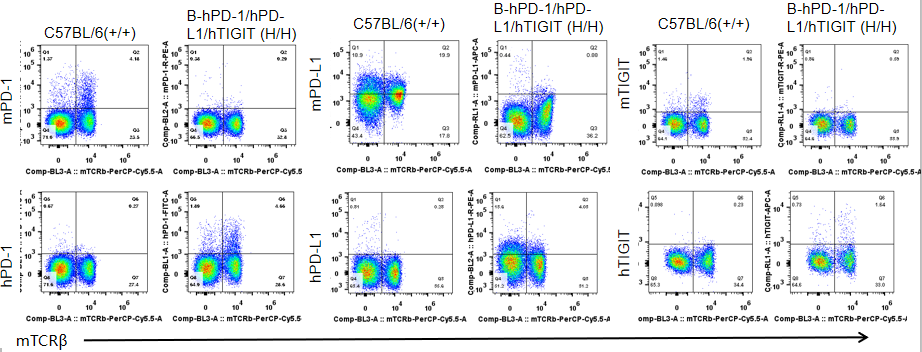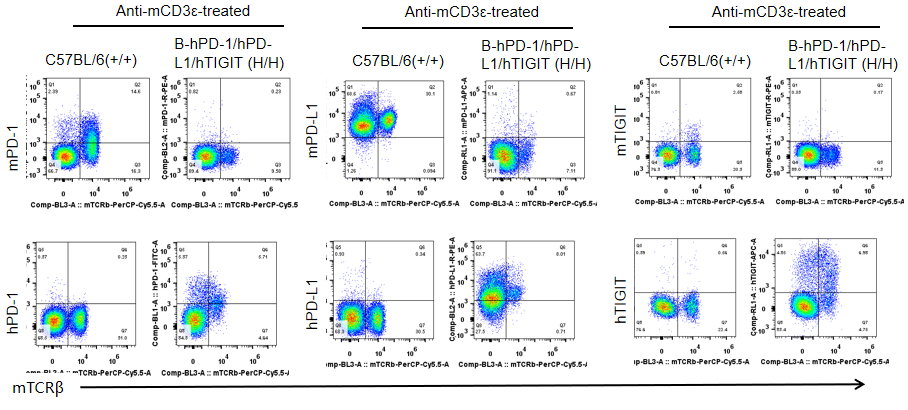


C57BL/6-Pdcd1tm1(PDCD1)Bcgen Cd274tm1(CD274)Bcgen Tigittm1(TIGIT)Bcgen/Bcgen • 130573
| Product name | B-hPD-1/hPD-L1/hTIGIT mice |
|---|---|
| Catalog number | 130573 |
| Strain name | C57BL/6-Pdcd1tm1(PDCD1)Bcgen Cd274tm1(CD274)Bcgen Tigittm1(TIGIT)Bcgen/Bcgen |
| Strain background | C57BL/6 |
| NCBI gene ID | 18566,60533,100043314 |
| Aliases | PD-1 (Programmed death-1); CD274 (CD274 antigen); TIGIT (T-cell immunoreceptor with Ig and ITIM domains) |
Gene targeting strategy for B-hPD-1/hPD-L1/hTIGIT mice. The exon 2 of mouse PD-1 gene that encodes the extracellular domain was replaced by human PD-1 exon 2 in B-hPD-1/hPD-L1/hTIGIT mice. The exon 3 of mouse pdl1 gene that encode the extracellular domain was replaced by human PD-L1 exon 3 in B-hPD-1/hPD-L1/hTIGIT mice. The exon 2 of mouse tigit gene that encodes the extracellular domain was replaced by human TIGIT exon 2 in B-hPD-1/hPD-L1/hTIGIT mice.

Strain specific PD-1, PD-L1 and TIGIT expression analysis in homozygous B-hPD-1/hPD-L1/hTIGIT mice by flow cytometry. Splenocytes were collected from WT and homozygous B-hPD-1/hPD-L1/hTIGIT (H/H) mice analyzed by flow cytometry with species-specific anti-PD-1 antibody. Mouse PD-1, PD-L1 and TIGIT were detectable in WT mice. Human PD-1, PD-L1 and TIGIT were exclusively detectable in homozygous B-hPD-1/hPD-L1/hTIGIT but not WT mice.

Strain specific PD-1, PD-L1 and TIGIT expression analysis in homozygous B-hPD-1/hPD-L1/hTIGIT mice by flow cytometry. Splenocytes were collected from WT and homozygous B-hPD-1/hPD-L1/hTIGIT (H/H) mice after stimulation with anti-CD3ε in vivo (7.5 μg/mice), and without stimulation, and analyzed by flow cytometry with species-specific anti-PD-1 antibody. Mouse PD-1, PD-L1 and TIGIT were detectable in WT mice. Human PD-1, PD-L1 and TIGIT were exclusively detectable in homozygous B-hPD-1/hPD-L1/hTIGIT but not WT mice. After anti-CD3ε stimulation, hPD-1 protein expression was significantly increased.

Antitumor activity of of anti-human anti-human PD-L1 Atezolizumab (in house) combined with anti-human Triagolizumab(in house) in B-hPD-1/hPD-L1/hTIGIT mice. (A) anti-human PD-L1 Atezolizumab (in house) combined with anti-human Triagolizumab(in house) inhibited MC38-hPD-L1 tumor growth in B-hPD-1/hPD-L1/hTIGIT mice. Murine colon cancer MC38-hPD-L1 cells (5×105) were subcutaneously implanted into homozygous B-hPD-1/hPD-L1/hTIGIT mice(female, 9 week-old, n=5). Mice were grouped when tumor volume reached approximately 100-150 mm3, at which time they were treated anti-human PD-L1 Atezolizumab (in house) combined with anti-human Triagolizumab(in house) with doses and schedules indicated in panel . (B) Body weight changes durin g treatment. As shown in panel A, combination of anti-hPD-L1 and anti-hTIGIT antibody shows more inhibitory effects than individual groups, demonstrating that the B-hPD-1/hPD-L1/hTIGIT mice provide a powerful preclinical model for in vivo evaluating combination therapy efficacy of hTIGIT antibodies and hPD-L1 antibodies . Values are expressed as mean ± SEM.